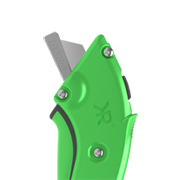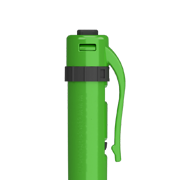CB100 Narrow Gap Concealed Blade Safety Knife

CB100 Narrow Gap Concealed Blade Safety Knife
Developed with and for safety professionals, the CB100 Narrow Gap is the ideal multi-purpose safety knife. The CB100 Narrow Gap's ergonomic ambidextrous handle, with easy tool-free blade change and guarded blade technology, avoids blade edges coming in contact with skin.
Riteknife Flowthrough Technology™ minimizes friction and maintains optimal blade angle to eliminate repetitive motion injuries and lower the force needed for cutting.
The molded tape splitter allows for easy penetration into clear packaging tapes as well as fiber-reinforced box tapes.
Product Specifications
Cutting Depth
5.8 mm
Weight
30 gms
Dimensions
175 mm x 40 mm x 6 mm
Materials
Glass filled nylon
CB100 Narrow Gap Accessories

Box of CB100 Narrow Gap Replacement Blades
Mozart® blades reduce friction and maintain sharpness while cutting materials including corrugated cardboard, shrink or stretch wrap, and plastic banding.

AP100 Holster / AP50 Holster
Makes it easy to keep an automatic safety knife ready for use. Also holds pens, markers spare blades and the CB100.
How to Use the CB100 Narrow Gap

Safety and Quality Go Hand in Hand
Frequently Asked Questions about the CB100 Narrow Gap and Concealed Blade Safety Knives
Is the CB100 blade changeable?
Yes, the Mozart®blade can be flipped over or changed.
How long will the CB100's blade last?
Depending on the material, it averages around 1,000 cuts per side.
How wide is the cutting gap?
6.5 mm
Can it be stored in a pocket?
While the blade is concealed, we'd recommend that the CB100 be stored and carried in a holster on the belt.
What does it cut?
It can cut tapes (plastic and fiber), plastic banding, single and double wall corrugated cardboard, stretch wrap, plastic and paper bags, and glued box flaps while avoiding product damage.
Why is the pull-through force so low?
The CB100 Flowthrough Technology has no molded plastic contacting what is being cut to increase the effective thickness.
What are some common materials or applications the CB100 cuts?
The most common applications for the CB100 are:
- Corrugated cardboard
- Shrink or stretch wrap
- Plastic Banding
- Tapes
What is a safety knife?
A safety knife is a type of knife that has special features such as protective guards, auto-retractable blades and blunt tips These tools are used to prevent lacerations and repetitive motion injuries.
What are common injuries caused by unsafe knives?
The two most common injuries caused by unsafe knives in the workplace and in factories are lacerations and repetitive motion injuries.
Lacerations are the most common injury caused by unsafe knives in the workplace. These occur when a person's body comes into contact with a blade that is being used.
Repetitive motion injuries are also common with poorly engineered knives in the workplace. These occur when someone uses a knife repetitively for long periods of time.. This can lead to carpal tunnel syndrome, tendonitis, or other musculoskeletal issues.
What is a safety knife?
A safety knife is a type of knife that has special features such as protective guards, auto-retractable blades and blunt tips These tools are used to prevent lacerations and repetitive motion injuries.
Why are safety knives important?
Safety knives are important because they can help you avoid injury and make your work easier. Safety knives are designed to protect both the user and others around them from injury. If you have a regular knife instead of a safety knife, then there's a chance that someone could get hurt by accident if their hand slips while they're using it.
Why is it important to combine training with your safety knife purchase?
The importance of combining training with your safety knife purchase is that it helps you learn how to use your new tool in a safe and effective manner. When your employees are trained on how to use their new safety equipment, they will be able to perform their jobs safely and confidently.
How do safety knives protect people?
Safety knives protect people by making sure they don't cut themselves. The sharp edge of a regular knife can easily cut someone's skin and cause serious injury, but safety knives are designed to prevent this type of accident.
How do I evaluate which safety knife is most effective for my organization?
The best way to evaluate which safety knives are best for your cutting tasks is by conducting a free safety knife evaluation and discussing your specific situation with a safety cutting professional.
What are common injuries caused by unsafe knives?
The two most common injuries caused by unsafe knives in the workplace and in factories are lacerations and repetitive motion injuries.
Lacerations are the most common injury caused by unsafe knives in the workplace. These occur when a person's body comes into contact with a blade that is being used.
Repetitive motion injuries are also common with poorly engineered knives in the workplace. These occur when someone uses a knife repetitively for long periods of time.. This can lead to carpal tunnel syndrome, tendonitis, or other musculoskeletal issues.
Contact
Our experts are here to help you find the Riteknife that fits your needs and goals.






